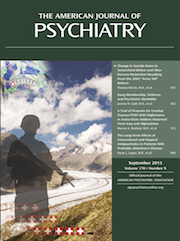The study by Coid et al. in this issue (
1) is remarkable not only for its striking findings, but for the fact that it was published in this journal at all. The
American Journal of Psychiatry, founded in 1844, has never before published an article with the word “gang” in the title, and has in its 169 years published only seven articles whose text included even a single passing reference to a research subject’s “gang” membership. The study of gangs, taken as a focal interest in the field of criminology since Thrasher’s
The Gang in 1927 (
2), has long been seen as foreign to mainstream psychiatry, and to forensic psychiatry as well.
Yet the conclusions of Coid and his colleagues strongly belie the validity of this capricious division of academic labor. The authors surveyed a nationally representative sample of young men in the United Kingdom who were in one of three groups: those who were neither violent nor in a gang; those who were violent, but not in a gang; and those who were both violent and in a gang. Not surprisingly, rates of drug dependence were 1%, 5%, and 57%, and rates of alcohol dependence were 6%, 14%, and 67%, respectively. Very surprisingly, however, rates of active psychosis were 1%, 5%, and 25%, and rates of prior admission to a psychiatric hospital were 2%, 5%, and 21%, respectively. Gang members, the authors are led to conclude, display “inordinately high levels” of psychiatric morbidity and place a “heavy burden” on mental health services in the inner-city areas where gangs are most prevalent. Given the parallels between gangs in the United Kingdom and gangs in the United States, there is little reason to think that the levels of morbidity or of burden are any different here (
3).
Two additional findings reported in this study have important implications for the process of violence risk assessment in psychiatricn patients in general. First, violent victimization and the fear of such victimization were found to be significantly higher among violent than nonviolent men, and higher still among violent gang members. This result underscores the conclusion of other researchers (
4) that victimization is a robust risk factor for the later commission of violent acts. Second, frequent violent ruminations and the propensity to react violently to perceived disrespect differentiated violent and nonviolent men but—as with victimization—were highest among violent gang members. This result, too, reinforces established findings that angry ruminations and sensitivity to provocation often anticipate violent behavior (
5).
Given these epidemiological findings, Coid and his colleagues cogently recommend that gang membership be routinely assessed in young men who present with psychiatric morbidity to inner-city health care services. Patients for whom questioning about being in a gang yields a positive response might further be directly asked their perceptions of the likelihood that they will commit a violent act in the future. Recent research by Skeem et al. (
6) found that patients’ response to the single question—“Given a scale of 0 to 5, where 0 is ‘no concern’ and 5 is ‘greatly concerned,’ how concerned should your therapist be that you might be violent in the next two months?”—added significant incremental validity to the risk estimates produced by two actuarial tools. At least in a research setting, patients seem disinclined to minimize or hide the likelihood of their own violence. Furthermore, eliciting patients’ self-perceived risk
casts patients as partners in a collaborative relationship—partners who hold expert information essential to the risk-management enterprise. Beyond helping potentially violent patients and their clinicians, the availability of a method for monitoring risk that is both feasible and accurate can only enhance public safety. [p. 414]
Psychiatry, as the article by Coid et al. vividly demonstrates, has much of value to contribute to the study of what has long been held to be the exclusive province of sociologically oriented criminology. As it happens, the field of criminology recently has taken a strong turn toward neuroscience (
7), and one day in the foreseeable future it may be able to make a complementary contribution to psychiatry.

